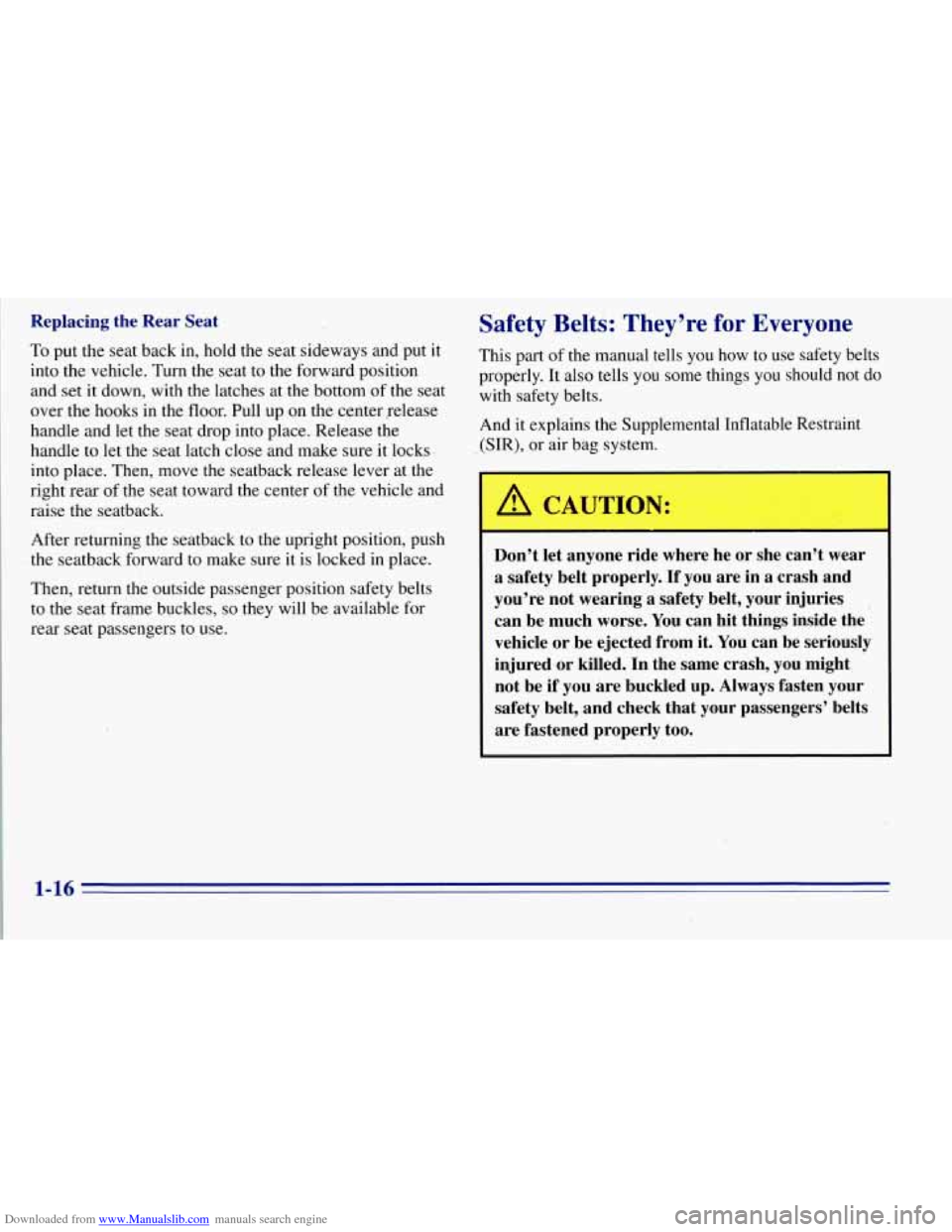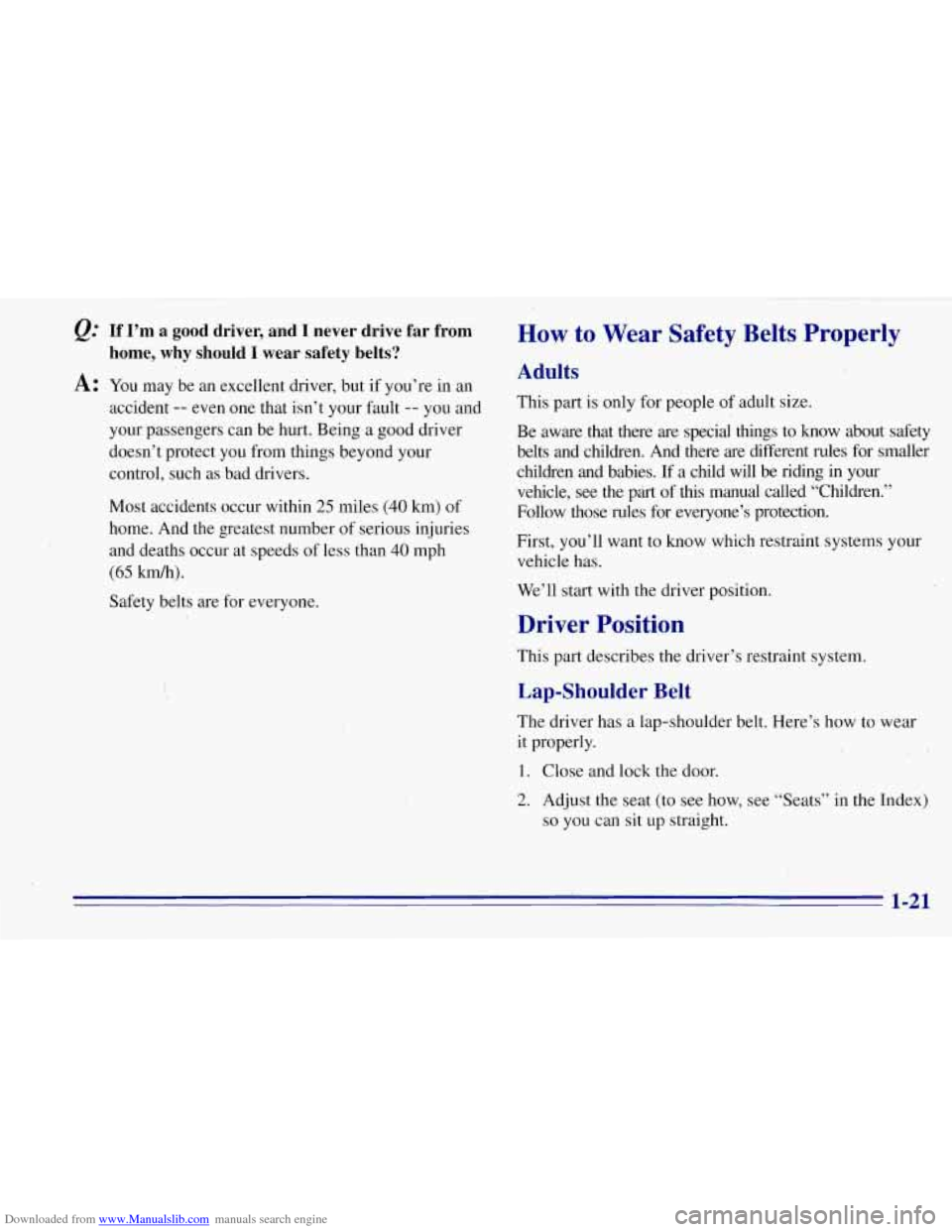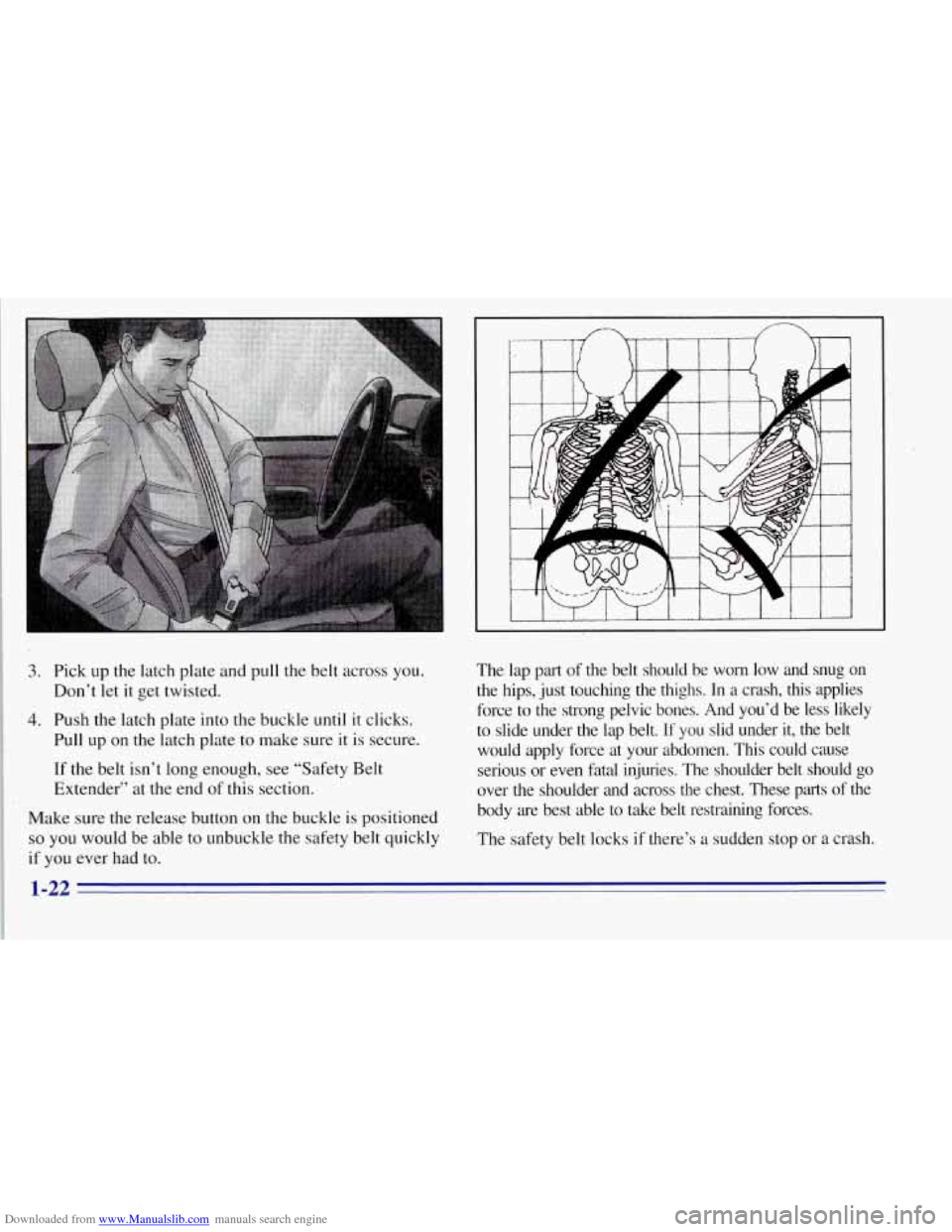Page 23 of 403

Downloaded from www.Manualslib.com manuals search engine Replacing the Rear Seat Safety Belts: They’re for Everyone
To put the seat back in, hold the seat sideways and put it This part of the manual tells you how to use safety belts
into the vehicle. Turn the seat to the forward position properly. It also tells you some things you should not do
and set it down, with the latches at the bottom of the seat with safety belts.
over the hooks in the floor. Pull up on the center ,release
handle and let the seat drop into place. Release the And it explains the Supplemental Inflatable Restraint
handle to let the seat latch close and make sure it locks
‘.(SIR), or air bag system.
into place. Then, move the seatback release lever at the
right rear of the seat toward the center of the vehicle and
raise the seatback.
After returning the seatback
to the upright position, push
the seatback forward to make sure it is locked in place.
Then, return the outside passenger position safety belts
to the seat frame buckles,
so they will be available for
rear seat passengers to use.
Don’t let anyone ride where he or she can’t wear
a safety belt properly. If you are in a crash and
you’re not wearing
a safety belt, your injuries
can be much worse. You can hit things inside the
vehicle or be ejected from it. You can be seriously
injured or killed. In the same crash, you might
not be if you are buckled up. Always fasten your
safety belt, and check that your passengers’ belts
are fastened properly too.
1-16
Page 28 of 403

Downloaded from www.Manualslib.com manuals search engine @ If I’m a good driver, and I never drive far from
A: You may be an excellent driver, but if you’re in an
home, why should I wear safety belts?
accident -- even one that isn’t your fault -- you and
your passengers can be hurt. Being a good drivei-
doesn’t protect you from things beyond your
control, such as bad drivers.
Most accidents occur within
25 miles (40 krn) of
home. And the greatest number of serious injuries
and deaths occur at speeds of less than
40 mph
(65 km/h).
Safety belts are for everyone.
How to Wear Safety Belts- Properly
Adults
This part is only for people of adult size.
Be aware that there are special things to know about safety
belts and children. And there
are different rules for smaller
children
and babies. If a child will be riding .in your
vehicle, see the
part of this manual called “Children.”
Follow those rules for everyone’s protection.
First, you’ll want to know which restraint systems your
vehicle has.
We’ll start with the driver position.
Driver Position
This part describes the driver’s restraint system.
Lap-Shoulder Belt
The driver has a lap-shoulder belt. Here’s how to wear
it properly.
1. Close and lock the door.
2. Adjust the seat (to see how, see “Seats” in the Index)
so you can sit up straight.
..
1-21
Page 29 of 403

Downloaded from www.Manualslib.com manuals search engine 1 I I I I i I i I I 1
3. Pick up the latch plate and pull the belt across you.
Don’t let it get twisted.
4. Push the latch plate into the buckle until it clicks.
Pull up on the latch plate to make sure it is secure.
If the belt isn’t long enough, see “Safety Belt
Extender” at the end
of this section.
Make sure the release button on the buckle
is positioned
so you would be able to unbuckle the safety belt quickly
if you ever had to. The lap
part of the belt should be worn low and snug on
the hips, just touching the thighs.
In a crash, this applies
force to the strong pelvic bones. And you’d be less likely
to slide under the lap belt.
If you slid under it, the belt
would apply force at
your abdomen. This could cause
serious or even fatal injuries. The shoulder belt should
go
over the shoulder and across the chest. These parts of the
body are best able to take belt restraining forces.
The safety belt locks if there’s a sudden stop or a crash.
1-22
Page 30 of 403
Downloaded from www.Manualslib.com manuals search engine Shoulder Belt Height Adjuster
Before you begin to drive, move the shoulder belt
adjuster to the height that is right for you.
To move it down, push in at the word PRESS and move
the height adjuster to the desired position.
You can move
the adjuster up just by pushing up
on the shoulder belt
guide. After
you move the adjuster to where you want it,
try
to move it down without pushing in to make sure it
has locked into position.
Adjust the height
so that the shoulder portion of the
belt is centered on
your shoulder. The belt should be
away from your face and neck, but not falling off
your shoulder.
1-23
Page 43 of 403
Downloaded from www.Manualslib.com manuals search engine The best way to protect the fetus is to protect the
mother. When a safety belt is
worn properly, it’s more
likely that the fetus won’t be hurt in a crash. For
pregnant women, as for anyone, the key to making
safety belts effective is .wearing them properly.
Right Front Passenger Position
The right front passenger’s s,afety belt works the same
way as the driver’s safety belt. See “Driver Position’’
earlier in this section.
#
When the lap belt is pulled out all the way, it will lock.
If it does,, let it go back all the way and start again.
Center. Passenger Position
Lap Belt
If your vehicle has front and rear bench seats, someone
can sit in the center positions.
1-36
Page 46 of 403
Downloaded from www.Manualslib.com manuals search engine 4-Door Utility
1. Pick up the latch plate and pull the belt across you.
2. Push the latch plate into the buckle until it clicks.
Don’t let it get twisted.
Pull up
on the latch plate to
make sure it is secure.
When the shoulder belt is pulled out all the way, it
will lock. If it does,
let it go back all the way and
start again.
If the belt is not long enough, see “Safety Belt
Extender” at the end
of this section.
Make sure the release button on the buckle is
positioned
so you would be able to unbuckle the
safety belt quickly if you ever had
to.
1-39
Page 48 of 403
Downloaded from www.Manualslib.com manuals search engine f
The lap part of the belt should be worn low and snug on
the hips, just touching the thighs. In a crash, this applies
force to the strong pelvic bones. And you’d be less likely
to slide under the lap belt.
If you slid under it, the belt
would apply force at your abdomen. This could cause
serious or even fatal injuries. The shoulder belt should
go
over the shoulder and across the chest. These parts of the
body are best able to take belt restraining forces. The
safety belt locks if there’s a sudden stop or a crash.
A
You can be seriously hurt if your shoulder belt is
too loose. In a crash, you would move forward
too much, which could increase injury. The
shoulder belt should fit against your body.
~~~~~
On four-door utility models, move the shoulder belt
height adjuster to the height that is right for
you.
1-41
Page 49 of 403
Downloaded from www.Manualslib.com manuals search engine To move the height adjuster down, push in at the word
PRESS and move the height adjuster to the desired
position. You can move the adjuster up just by pushmg up
on the shoulder
belt guide. After you move the adjuster to
where you want it, try to move it down without pushing in
to make sure it has locked into position.
Adjust the height
so that the shoulder portion of the belt is
centered on your shoulder. The belt should be away from
your face and neck, but not falling
off your shoulder. 2-Door Utility and Suburban
1-42